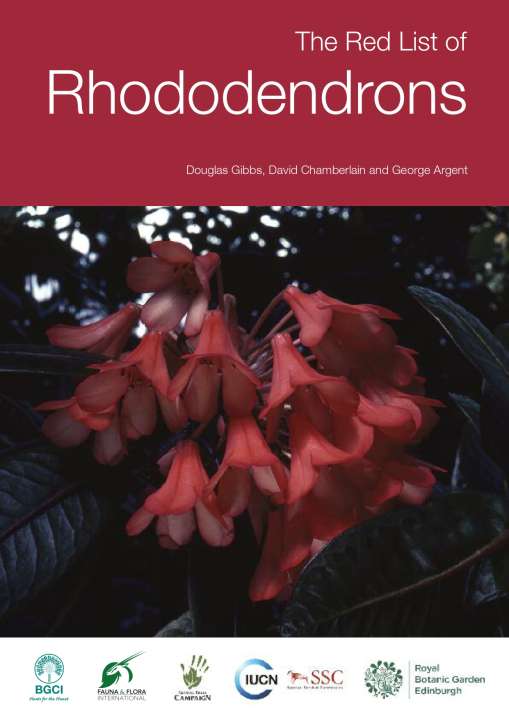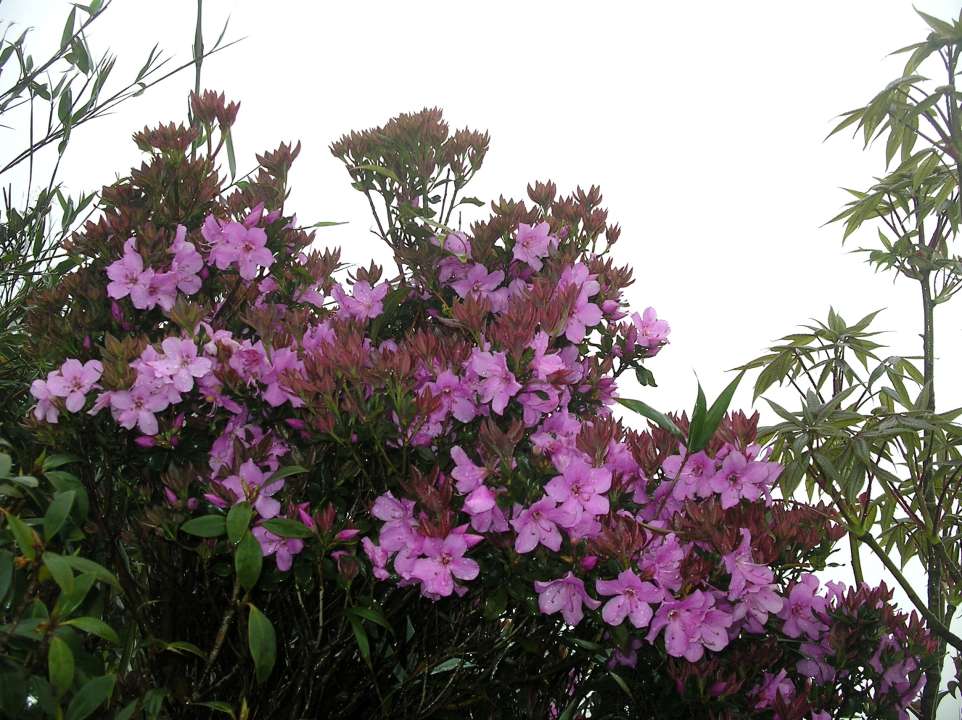Red list Rhododendrons and the Ark Project

Rhododendron Species Conservation in the wild and in cultivation (ex situ)
In 2011, The Red List of Rhododendrons was published. This research produced conservation assessments for Rhododendron species and showed that approximately a quarter (316) of the 1157 species are under threat in the wild and require conservation action.

Rhododendrons are popular horticultural plants are also valued for their medicinal properties, and in some communities they are used for firewood, timber, teas, honey, wine, jams, narcotics, etc, and also as sources of insecticides.
In the wild, they are mainly associated with centres of diversity in the Himalayas and in South East Asia, where they form important components of montane ecosystems.
https://www.globalconservationconsortia.org/resources/the-red-list-of-rhododendrons/
The red listing of rhododendrons was a flawed publication and needs a great deal of revision:
- Many of the tax listed with being threatened are not. Many are inconsequential natural hybrids
- 290 taxa have insufficient data to evaluate them.
- Many of the most knowledgeable people on wild rhododendrons were not consulted in the original survey. The publication was rushed.
- There is a degree of 'political correctness' involved which can result in a failure to point out where the conservation crises exist. Logging in N Burma for export of wood to China, Low altitude rhododendrons in China and Northern Vietnam are all crisis areas. N Vietnam and adjacent S Yunnan is a biodiversity hotspot with isolated peaks and many endemic rhododendrons. Though the area in Vietnam is a declared National Park, there is little or no policing of the destruction of the forest for farming cardamon and other crops. BGCI seem reluctant to point this out. It is essential that they do. The very real threats need to spelled out. It may be necessary to call out governments, in order to protect habitat.
Despite the Red List shortcomings, the principal of listing species threatened in the wild is an excellent one.
And if due to population, climate change, road building, mining, deforestation, a rhododendron taxon is threatened then there should be a three part approach to its conservation:
1. Assessment of the distribution of the species concerned through fieldwork or reportage of previous fieldwork.
2. An attempt to ascertain immediate and likely threats to the wild population or populations.
3. Ex situ (cultivated) conservation in other countries.
Ex Situ conservation at present tends to be little more than listing specimens in collections. This is of limited value as these individual plants have little conservation value as they cannot be easily used for seed raising. What is needed is substantial plantings of 10-20 up to 100s or more of the same species, if possible isolated from near relatives, so that a living seedbank and almost infinite amounts of seed can be produced and distributed. Seed can also be seed banked. Hand pollination (where insects are prevented from hybridising) is essential so that the seed raised offspring are correct.
RHODODENDRON LIST LIST FINDINGS 2011
Classification of Species Assessed
- Extinct 1
- Extinct in the Wild 1
- Critically Endangered 36
- Endangered 39
- Vulnerable 241
- Near Threatened 66
- Data Deficient 290
- Least Concern 483
My proposal I have called the 'Rhododendron Ark' which is based on the rational of the ICONIC conifer conservation now called the Perthshire Tree Conservation Program, where substantial number of accessions of endangered conifer species have been planted in plantations which in due course will produce large numbers of cones which can be used for in situ or ex situ conservation. Tom Christian from RBGE Edinburgh was a key player in this project's genesis.
Examples of rhododendron species which are endangered
All the endemics in N Vietnam and S Yunnan. Examples include
Rh. fansipanesis very few mature plants left on Fan Si Pan.
Rh sinofalconeri only occurs in a few peaks on both sides of the border
Rh. serotinum Aff S Yunnan and N Vietnam.
Rh. onii only known from Fan Si Pan, Vietnam
Rh rushforthii epiphyte. Little known in the wild. 1-2 locations.
Rh. oblongolobatum
Rh. suoilenhense known from two peaks. very rare. Cardamon farming is threatening it
Rh arboreum outlier populations.
This very variable species has a wide distribution.
There are many populations of subspecies which are isolated and very vulnerable.
include R arboreum delavayi on Mt Victoria, Myanmar, And Doi Inthanon, Thailand (5 plants), ssp niligiricum in the Palni hills S India and ssp. zeylanicum in Sri Lanka.
Rh niveum.
Entry from the Red List 2011
J.D.Hooker VUD2 Bhutan, China (Xizang), (Sikkim)
A tree or shrub with mauve flowers,with or without a deeper lilac blotch. Known from one or two localities in each country in mixed forests and rocky valleys. Occurring within protected areas, but possibly threatened by the small number of localities.
R acrophilum
Red list entry: An epiphyte in dense montane rain forest, only known from Mt Mantalingahan with a distribution under 100 km2. There is nearby forest destruction and degradation although there is no evidence of direct population decline.
R chapmanii
Rhododendron Conservation is not just a 3rd world issue. One of the most threatened species is in Florida, USA.
United States of America (Florida) Only 32 known populations from Liberty, Gulf, Gadsden, and Clay counties, Florida. Changes in hydrology and soil structure from logging and clear cutting, as well as over-collection have negative impacts on this species which has a very specialised habitat requirement. Forty populations totalling 2,969 plants were found in 1997 census – 14 populations declined since 1984/5 survey. Very poor to non-existent regeneration is widely reported. Ranked as Globally Imperilled (G1) by NatureServe
R. changii
Rhododendron changii (W. P. Fang) W. P. Fang CR C2a (i,ii); D China (Chongqing) Found in 1983 in Jinfushan National Park, a popular tourist site, the deep yellow flowered small shrub is known to have a very small population (<50 mature plants) and is restricted to a single locality in an area where the forest habitat is under significant pressure and disturbance; the species is therefore very threatened. Refs: 8, 9
How would the ark project work
- Using the Red List and more up to date information, draw up a list of temperate (non tropical) rhododendron species which are classified as Critically Endangered or Endangered for which material is or can be made available. A separate list of Vireya rhododendron species should be made. (these can only be grown outdoors in frost free climates.)
- Gardeners, private and public would designate an area to plant with a significant number of a threatened rhododendron species. Ideally this species should be as suitable as possible for the climate that it is planted in and hardy enough to withstand severe winters.
- It is unlikely post NAGOYA that seedlings would be available from wild sources. But they should be from hand pollinated authenticated parents from known wild sources.
- If collectors' data of the parent plants are available with the location of collection, so much the better.
- The plants should not all be vegetatively propagated from a single clone. As many clones as possible should be grown.
- Species with wide distribution and variation would be best grown in a collection from a single geographical area. R wardii for example from Tibet or Yunnan or Sichuan but not mixed.
- The collections should be labelled and mapped as part of the conservation project. Ideally national trust gardens, botanic gardens and other larger properties would be encouraged to plant Rhododendron Ark project collections. Tasmania, New Zealand, USA and Canada and much of Northern Europe would be suitable sites. Japan would be also be suitable in mountain areas.
- Potential Partner Organisations for seed, material, information and coordination. Rhododendron Species Botanic Garden, Bremen Rhododendron Garden, RBG Edinburgh, The Rhododendron Species Conservation Group, National Trust (UK), National Trust for Scotland, the Saville and Valley Gardens, Windsor. In New Zealand, the Pukeiti Rhododendron Trust and Massey University’s Marion MacKay, have established a Rhododendron Conservation Collection at Dunedin Botanic Garden.
